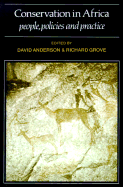Book contents
- Frontmatter
- Contents
- Preface
- List of contributors
- Introduction: The scramble for Eden: past, present and future in African conservation
- Part One Conservation ideologies in Africa
- Part Two Wildlife, Parks and Pastoralist
- Introduction
- 5 Pastoralism, conservation and the overgrazing controversy
- 6 Pastoralists and wildlife: image and reality in Kenya Maasailand
- 7 Integrating parks and pastoralists: some lessons from Amboseli
- 8 The Mursi and National Park development in the Lower Omo Valley
- Part Three Conservation priorities and rural communities
- Part Four Consequences for conservation and development
- Index
8 - The Mursi and National Park development in the Lower Omo Valley
Published online by Cambridge University Press: 04 April 2011
- Frontmatter
- Contents
- Preface
- List of contributors
- Introduction: The scramble for Eden: past, present and future in African conservation
- Part One Conservation ideologies in Africa
- Part Two Wildlife, Parks and Pastoralist
- Introduction
- 5 Pastoralism, conservation and the overgrazing controversy
- 6 Pastoralists and wildlife: image and reality in Kenya Maasailand
- 7 Integrating parks and pastoralists: some lessons from Amboseli
- 8 The Mursi and National Park development in the Lower Omo Valley
- Part Three Conservation priorities and rural communities
- Part Four Consequences for conservation and development
- Index
Summary
Let me begin with two anecdotes. In 1970 I met a foreign advisor to the Ethiopian Wildlife Conservation Department at the Department's Headquarters in Addis Ababa. On the wall of his office was a map of the Lower Omo Valley, showing the boundaries of two designated National Parks, the Omo National Park and the Mago National Park (see Fig. 8.1). Between the two parks was a narrow wedge of territory which had been labelled ‘Tama Wildlife Reserve’. (‘Tama’ is one of several names for the Mursi, among whom I was then carrying out my first period of anthropological fieldwork.) I asked the advisor if he was aware that there were 5,000 or so Mursi living between the Omo and Mago rivers and that, if they were excluded from the proposed parks, their subsistence system would collapse. At first he claimed that the area was uninhabited: he had flown over it many times and had seen no ‘villages’. And then, after I had persuaded him that the Mursi did indeed exist, he merely brushed this information aside with the observation that the game wardens would need to employ a good deal of local labour!
During the 1970s the Mursi experienced their worst drought and famine in living memory. This led, at the end of the decade, to a migration from the drought-prone Omo Lowlands to higher land in the Mago valley where a more reliable rainfall offered better prospects for cultivation.
- Type
- Chapter
- Information
- Conservation in AfricaPeoples, Policies and Practice, pp. 169 - 186Publisher: Cambridge University PressPrint publication year: 1988
- 4
- Cited by



